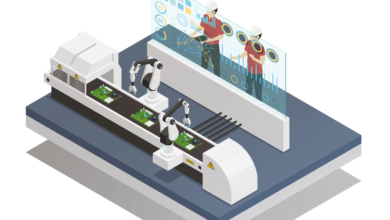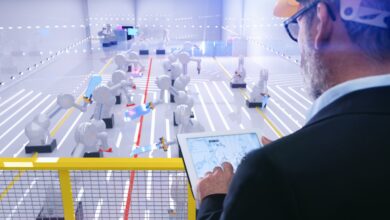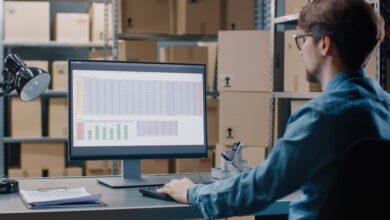Simulation is a Window to The Future of Your Manufacturing Operation

The concepts of modeling and simulation have been defined by the US National Academy of Engineering and National Research Council as a “technological breakthrough that has a profound impact on manufacturing performance.” If you are among the many SMEs who recognize that simulation is a critical analysis tool for design and validation, then you’re in a great position! Because you are one step ahead of your competitors who may not yet have sufficient awareness in the industry!
The simulation services we offer to SMEs as a low-cost, secure, and fast analysis tool are becoming increasingly important. The unforgiving nature of the manufacturing process highlights the value of a qualified simulation’s powerful impact. However, adopting a simulation approach in manufacturing, which is at the critical point of the supply chain, is necessary to minimize the problems caused by fluctuations in the supply chain, respond quickly to needs, and provide flexibility.
Simulation Services
Simulation services have the capability to provide data-based concrete solutions. No other tool can simultaneously offer services to shorten the product development cycle, perfect the processes you conduct, and reduce the cost of bringing the product to life. Considering today’s competitive market, all of these services will help you establish a strong position in the market for your company and thereby increase revenue.
The Importance of Simulation Method for SMEs
Meeting the demands required to improve performance and introduce new services is crucial. This is where simulation comes to your aid. Offering opportunities to reduce costs and increase quality, simulation is the exact service you need. One of the most important ways for SMEs to maintain their presence in the race is to seek help from advanced engineering tools such as simulation that have become a culture in SMEs.
Simulation offers a wide range of benefits, from strengthening collaboration with your customers, equipment suppliers, and supply chain partners to providing a preview of how a product will be produced. Thus, you can prepare a virtual representation of your production facility for your customers and internal teams and demonstrate your value stream. Moreover, if you need to make a change in the flow, creating a new version is easier with simulation. Simulation eliminates the need for old-fashioned physical trial and error methods that often require changes to the manufacturing line setup.
Why Do We Need Modeling Method?
Simulation helps you test a system for an unlimited period and see how much you can push the system. This is not something that can be easily done in a physical factory. The reasons for using simulation can be listed as follows for all SMEs regardless of the sector:
- Enhancing system performance with Decision Support System (DSS),
- Activating the Risk Assessment method (What If Analysis),
- Providing the ability to cope with the complexities of variables and dynamic structures,
- Supporting focus on the smallest details.
Simulation with Analytical and Management Ability
In addition, simulation will be your greatest helper in the analysis phase of your processes and in the following stages:
- Identifying factors causing system bottlenecks,
- Facility layout: Providing management of parameters such as routing, stock, batch sizes, cycle times, and control systems for optimum layout,
- Changes in production stage: Including new products, changes in demand models, changing product mix, changing lead times, and production schedule.
- Observing system performance: Efficiency, capacity, resource utilization rates, OEE.
- Observing resource utilization: Raw material usage, labor usage, machine usage, equipment usage.
- You can benefit from simulation to analyze many variables such as confirming the expected performance of new or existing production facilities.
Problems Start with the Process, Time Constraints, and High Costs
The most common obstacles encountered during the application phase, which requires cooperation between departments and potential suppliers, are as follows:
- Time-Consuming: The development stage of the simulation model is labor-intensive. Some complex simulation projects can take months to complete. This may intimidate SMEs. However, many projects can be completed relatively quickly and with less effort. Allocating time to simulation services for a project involving critical tasks can save the company from large expenses. Additionally, you can observe details that you didn’t notice before with simulation assistance.
- Cost: Many simulation packages cost tens of thousands of dollars for a single license and require high-level computer hardware. These are all separate high costs. The company must eventually choose between purchasing software or hiring an external consultant. Therefore, it benefits from ROI analysis.
The goal should be to make simulation a part of SME culture. Therefore, one of the points that companies that build simulation models or consultancies should pay attention to in order to effectively manage their projects is to have an employee trained in simulation within the company. With simulation becoming a culture in SMEs, solutions can be created for countless problems, and maximum benefit can be obtained. The long-term use of simulations is a unique advantage for improving your manufacturing operations.
- Project Management: Difficulties in understanding simulation still pose a major problem today. Also, there may still be a level of mistrust in simulation or misunderstanding of its capabilities. Senior management may have a general distrust of new methods or misunderstand the capabilities of simulation. Although every scenario can be simulated, it would not be correct to say that simulation is the “best solution to all problems.”
- Technical Skills: Learning simulation methodologies and software is only part of what is required to be an effective modeler. The person modeling the simulation must create a model and interpret the results. They must be able to address issues in the model. Acquiring problem-solving and troubleshooting skills is a time-consuming ability.
Review Your Operation in Detail
Simulation can be categorized among the basic needs of manufacturing companies today because it draws attention to details and develops a new perspective. Simulations document all details. Also, it allows you to have more information about your operation. It enables you to see the interaction between processes that you may overlook in a spreadsheet or analyze.
Yes, simulation can be costly. However, it is worth considering that it will eliminate the extra expenses you will incur for subsequent analyzes. As with any value creation process, investment, education, and time are required for using this service. If you already have a lean manufacturing project and engineering infrastructure, you may be ready to use simulation. Thus, a model that allows you to see the big picture in case of any disruption will be ready for you.
Most SMEs start with small projects in simulation systems. These projects include simulating a path, applying heat algorithms to see if a part will change shape or wear out, or not. Now you will be able to take on even more complex simulations. For example, you can determine whether to use conveyors or pallet trucks for material handling, and improve your flow times and resource utilization rates.
Get in Touch Now
Many major manufacturers in the automotive and aerospace sectors use simulation. However, high-mix, low-volume (HMLV) SMEs, which are difficult to model, may have difficulty finding the time and expertise required to model and validate.
Are you having trouble getting started with modeling and simulation applications? Dijitalis is ready to assist you with its expert team. Test your ideas before designing the future plant. Contact us today to start your project immediately.





